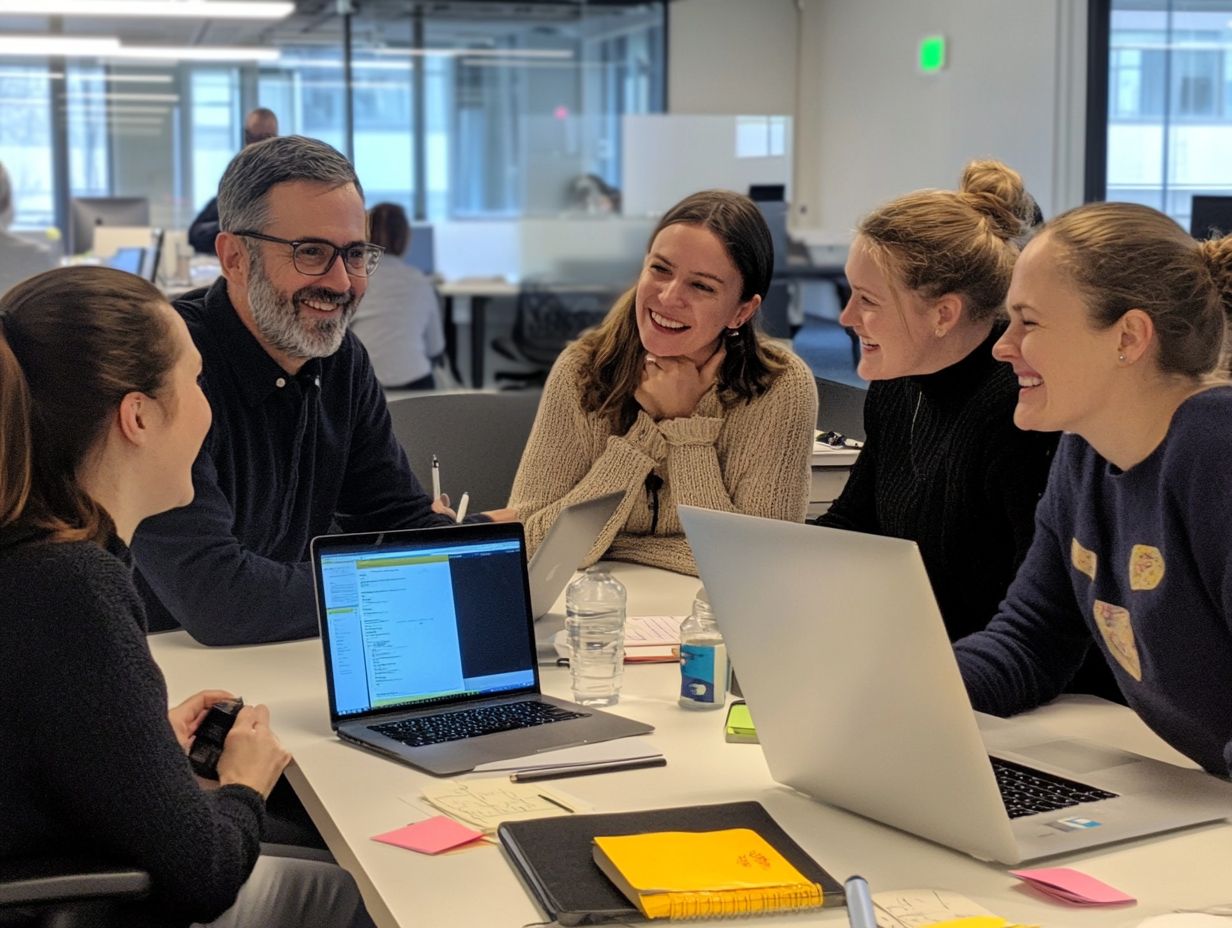Curiosity is not merely a trait; it serves as a powerful catalyst for career success. This article examines how curiosity can transform the workplace, fostering innovation and personal growth. We will begin by defining the concept of curiosity and then explore its tangible benefits. Additionally, we will discuss effective strategies to cultivate this essential skill, emphasizing the importance of lifelong curiosity as a powerful asset in both personal development and professional paths. Readers will also encounter inspiring examples of leaders who leverage their curiosity to achieve excellence through creative solutions, strategic asset utilization, and engaging curiosity practices. We will address common barriers to curiosity, providing insights on how to unlock its full potential in one’s career. Engage with us on this journey to harness curiosity as a pivotal asset for your professional development.
Key Takeaways:
The Power of Curiosity and Its Impact on Professional Growth

Curiosity is widely recognized as a valuable asset in both personal and professional contexts, serving as a catalyst for lifelong learning, continuous development, and fostering a questioning mindset essential for effective leadership. It enables individuals to explore new concepts, pose critical questions, and pursue knowledge that can result in innovative solutions, transformative technologies, and the development of a curiosity-driven approach.
Effective leaders acknowledge that adopting a questioning mindset not only enhances their self-awareness and empathy but also promotes collaboration, connected thinking, and engaging curiosity among diverse teams. By fostering curiosity, organizations can unlock new perspectives that drive professional growth, cultivate a culture of resilience, and enhance market adaptability, which is essential for successfully navigating the complexities of today’s dynamic business environment (as highlighted in a recent Harvard Business Review article).
Defining Curiosity’s Role in Career Success and Leadership Behavior
Curiosity is defined as a strong desire to learn or know something, and it plays a vital role in achieving career success by fostering lifelong learning, personal development, and innovative approaches.
When individuals actively embrace this trait, they become receptive to new ideas, experiences, and perspectives. This inquisitive mindset not only stimulates innovative thinking but also builds resilience in the face of challenges.
By consistently pursuing new knowledge and skills, individuals can more effectively adapt to evolving industry demands and professional paths, thereby enhancing their professional profiles. Curiosity promotes engagement and collaboration, resulting in stronger networks and more meaningful professional relationships. According to Psychology Today, this mindset enriches personal journeys and positions individuals for greater opportunities and accomplishments in their careers.
Curiosity in the Workplace
In the workplace, curiosity serves as a catalyst for innovation and growth. It encourages employees to actively seek out business insights and challenge established norms, thereby fostering a culture of continuous improvement and effective problem-solving.
How Curiosity Drives Innovation and Growth

Curiosity serves as a catalyst for innovation and growth by inspiring creative solutions, fostering an environment in which leadership is characterized by empathy, open-mindedness, and humility.
When team members are given the power to ask questions and explore new ideas, they are more likely to uncover unique insights that can lead to significant advancements. Leaders can cultivate a culture of curiosity by promoting brainstorming sessions, where every idea is welcomed and valued, irrespective of its perceived feasibility.
For example, organizations that invest in roles such as organizational librarians gain access to specialized knowledge that facilitates the sharing and exploration of information across departments. This practice not only enhances collaboration but also aligns with the organization’s strategic objectives, enabling transformative impacts that drive competitive advantage. Forbes highlights how curiosity-driven initiatives fuel innovation, offering a pathway to discovery that aligns with strategic objectives.
The Benefits of Being Curious
The advantages of cultivating curiosity extend well beyond the acquisition of immediate knowledge; they include substantial opportunities for personal development, professional advancement, increased community engagement, and effective problem-solving.
Personal and Professional Development
Curiosity serves a crucial function in both personal development and professional advancement by motivating individuals to explore knowledge, build meaningful relationships, and engage in curiosity-led educational experiences. This intrinsic desire to learn drives individuals to delve deeper into unfamiliar subjects, thereby fostering an enriching environment of continuous learning.
In professional contexts, for instance, an employee who embraces curiosity may actively seek out cross-departmental collaborations, resulting in innovative ideas and enhanced teamwork.
On a broader scale, curiosity has been the catalyst for transformative technologies, including artificial intelligence and renewable energy solutions. Researchers, propelled by an ambition to comprehend complex systems or address urgent global challenges, have pioneered advancements such as machine learning algorithms and improvements in solar panel efficiency.
These innovations not only improve daily life but also inspire networks of collaborators who collectively share a vision of progress.
Nurturing Curiosity

Fostering curiosity is crucial for both personal and professional development.
There are numerous effective methods to cultivate curiosity within one’s career, including participation in engaging workshops and ongoing exploration of new ideas and experiences.
Ways to Cultivate Curiosity in Your Career
Cultivating curiosity in one’s career can be effectively achieved through various methods, including the adoption of a curiosity-driven approach and participation in engaging workshops that promote new learning experiences.
These workshops not only provide fresh insights but also create opportunities for networking with like-minded individuals, thereby fostering valuable professional relationships.
By developing a growth mindset, individuals can view challenges as opportunities for learning and personal growth rather than as impediments. Encouraging oneself to ask questions and seek diverse perspectives can spark a passion for continuous improvement.
Moreover, engaging in discussions or forums that cover relevant topics of interest can inspire innovative thinking and enhance one’s knowledge base, ultimately contributing to personal satisfaction and professional success.
Curiosity as a Career Superpower
Curiosity can be regarded as a significant career superpower, enabling successful leaders and entrepreneurs to leverage their innate curiosity and resilience to effectively navigate challenges, capitalize on opportunities, and embrace humility in their professional endeavors.
Examples of Successful Leaders and Entrepreneurs Who Embrace Curiosity

Many esteemed leaders and entrepreneurs, including Brian Grazer and Peter Drucker, exemplify the fundamental principle of curiosity, which has significantly influenced their careers and had a transformative effect on their organizations.
For instance, Grazer, in his distinguished career as a Hollywood producer, has consistently engaged in conversations with individuals from diverse backgrounds. This practice has not only fueled his creativity but has also resulted in the production of groundbreaking films. His inquisitive nature has enriched his storytelling and fostered a culture of innovation within his team, encouraging them to think creatively.
Similarly, Drucker, recognized as the father of modern management, highlighted the significance of formulating the right questions to adapt to evolving business environments. By encouraging leaders to explore the motivations and behaviors of their employees and customers, he cultivated an atmosphere in which curiosity served as a catalyst for strategic thinking, enabling organizations to thrive in competitive landscapes.
These examples demonstrate how the embrace of curiosity can propel both individuals and organizations toward unparalleled success.
Overcoming Barriers to Curiosity
Addressing barriers to curiosity, such as fear and resistance, is essential for fostering a workplace culture that promotes a curiosity-driven approach.
Addressing Fear and Resistance to Curiosity in the Workplace
Addressing fear and resistance to curiosity in the workplace necessitates that leaders implement strategies designed to cultivate an environment of open communication, promote curiosity as a strategic asset, and foster transformative impacts through curiosity resilience.
Leaders play a pivotal role in shaping this environment by exemplifying curiosity themselves and actively engaging in discussions that invite new ideas.
Organizations can take practical steps such as:
- Establishing regular brainstorming sessions where all employees feel secure in sharing their thoughts without fear of judgment.
- Providing training programs that underscore the significance of creative thinking.
Recognizing and rewarding innovative solutions serves to reinforce a culture of exploration. By actively fostering an atmosphere where inquiries are welcomed and experimentation is encouraged, organizations not only mitigate fear but also stimulate a passion for learning among their teams.



